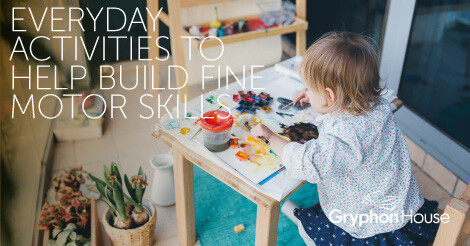Movement is one of the greatest ways kids learn. As soon as they can walk, children run, jump, and dance to explore their world and express themselves. Movement is not only good for children’s fitness and imagination; it is also vital in developing children’s motor skills. Motor skills are often split into two groups: gross motor skills, which make up large movements like swinging arms or crawling on knees, and fine motor skills, which are the smaller movements of the hands and feet.
Movement is one of the greatest ways kids learn. As soon as they can walk, children run, jump, and dance to explore their world and express themselves. Movement is not only good for children’s fitness and imagination; it is also vital in developing children’s motor skills. Motor skills are often split into two groups: gross motor skills, which make up large movements like swinging arms or crawling on knees, and fine motor skills, which are the smaller movements of the hands and feet.
Fine motor skills development is what teaches children to write with a pencil, kick a soccer ball, and pick up food to feed themselves. This is why building fine motor skills in toddlers is so important. Fine motor skills activities strengthen both the muscles and neural pathways that make tiny movements possible. Here are some fun activities from Joye Newman and Miriam P. Finberg’s book Move to Learn that will strengthen children’s fine motor skills and can be easily done at home.
I Can Feel that Number
What to Do:
- Tell your child you will be taking turns writing numbers on one another’s backs with your fingers. Whoever’s back is being “written” on will guess the number the other person writes
- Demonstrate by using your finger to draw a number from zero to nine on your child’s back. Ask them if they can guess the number you’re writing
- Take turns doing the exercise
BONUS: After the exercise, have your child use finger paint to draw out a number on a piece of paper.
How this Builds Fine Motor Skills:
The drawing of the numbers enhances a child’s sense of tactile processing. The definitive shape of each number also urges children to move their fingers in a specific way, which builds accuracy of movement.
Let’s Make a Color Bracelet
What to Do:
- Make your child a bracelet out of masking tape that has the sticky side out
- Go outside and walk around. Ask your child about the colors they see
- Together, look for things outside that are green. Encourage your child to pick up green things they think are pretty and stick them to their bracelet (Note: Don’t let them touch or pick up bugs or other living creatures)
- Do the same with things that are red, brown, blue, and yellow
- When you go inside, talk with them about the different things on their bracelet
BONUS: Take the bracelet and cut it so that you can spread it out flat. Glue it to a piece of paper to keep as an art piece.
How this Builds Fine Motor Skills:
The act of picking things up and putting them on the bracelet requires delicate movement of the fingers, but the stickiness of the tape makes placing the items on the bracelet easier and lets children practice this skill without getting frustrated.
Let’s Go Fishing
What to Do:
- Make a fishing rod using a 12” stick, some string, and a magnet. Tie one end of the string to the stick and the other end to the magnet
- Fill a plastic basin or tub with water and add a variety of small objects (erasers, paper-clips, corks, bolts, etc.). Make sure that some of the objects are metal and will stick to the magnet
- Give your child the fishing rod and ask them to predict what they will catch with it
- Let them try to catch items with their fishing rod. Ask them why they think some items are sticking and some are not
- If your child is consistently picking items that are non-magnetic, encourage them to try fishing for the metal objects (Be specific, like “Why don’t you try catching the screw at the bottom?”
BONUS: Have your child take the items they caught and try to arrange them to look like a fish.
How this Builds Fine Motor Skills:
Moving the fishing rod to catch items requires hand-eye coordination and accuracy of movement. When children try to catch a specific item, they add purpose to their movement, which further strengthens motor skills.

